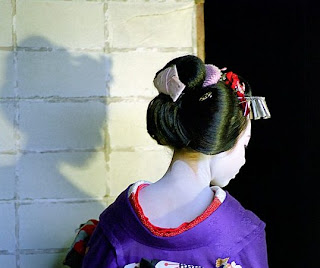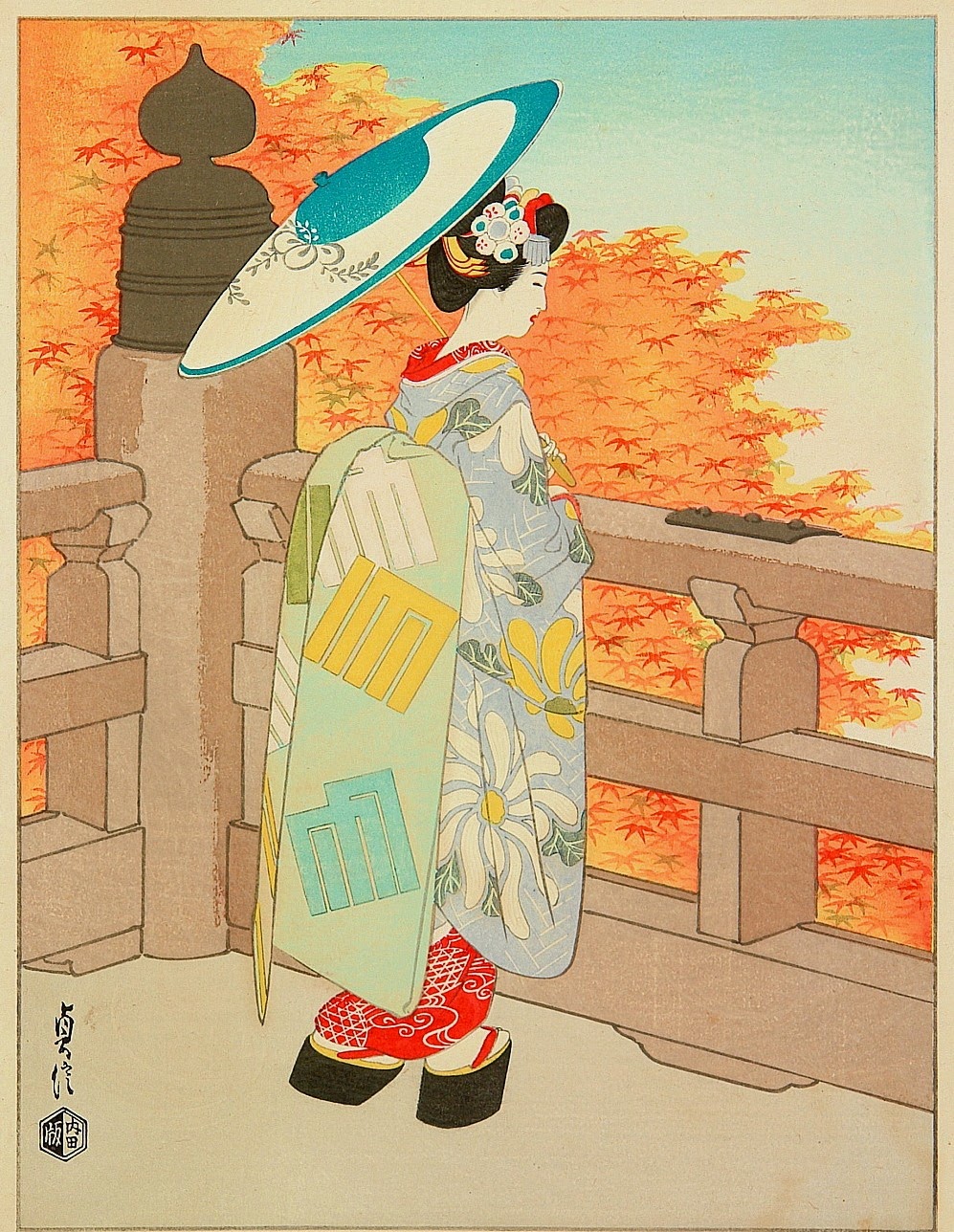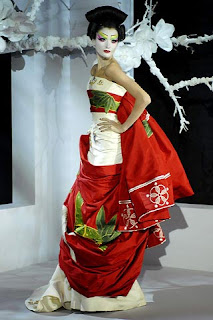“Remember Chiyo, geisha are not courtesans, and we are not wives. We sell our skills, not our bodies. We create another secret world, a place only of beauty.
The very word 'geisha' means artist, and to be a geisha is to be judged as a moving work of art.” ~ Memoirs of a Geisha (Arthur Golden, 1997)
Geisha in Fall Leaves
“The heart dies a slow death, shedding each hope like leaves...
Until one day there are none.” ~ Memoirs of a Geisha (Arthur Golden, 1997)
Oftentimes, the geisha of Japan are crudely interpreted by outsiders as little more than pampered courtesans or worse, as highly paid prostitutes. But the truth is much less crude: a geisha is a performing artist. In fact, the word for geisha may be construed to mean artist - it is a variation of a person and art. Geisha are highly cultured women rigorously trained from an early age in the refined arts and subtleties of conversation, music, singing, dance and tea ceremonies, for instance. But our main concern here are the hairstyles of the geisha.
As with all aspects of a geisha's life, there are variations between geishas - age, experience, status, etc. - and what they wear and how they dress their hair or apply their make-up reflects those differences between them. It is, therefore, important to distinguish between them.
Fan Geisha ~ (Edo period)
The above two images are both courtesy of: http://katescorner.e-monsite.com/
A Maiko is a young, novice geisha (or the term may even refer to a child born into geisha life). Generally speaking, after the age of 21, a young woman ceases to be considered a Maiko; essentially, she is too old at that age to be called one. But while a girl is still a Maiko, she wears certain hairstyles specific only to her title of Maiko, including thickly applied coats of traditional white face makeup as well as bright red lipstick. It is these hairstyles which categorically distinguish a Maiko from her older 'sisters,' commonly known as Geiko. (Source: patrickmccoy.typepad.com, 2007)
Itsutomi - Geisha with shamisen by Hosoda ~ 1793
Image courtesy of: http://www.vintagevenus.com.au/
The first thing a young Maiko needs to do is grow her hair long enough for it to be dressed in a befitting manner. During her training or apprenticeship under the tutelage of an older 'sister,' a Maiko will be arrayed in up to five different hairstyles: wareshinobu, ofuku, sakkou, katsuyama and yakko-shimada. The latter two hairstyles are usually worn on special occasions by senior Maiko and the sakkou style is worn by a Maiko on her graduation ceremony, signalling her transformation from Maiko to Geiko. (Source: patrickmccoy.typepad.com, 2007)
A Maiko in Tokyo
Image courtesy of: http://fiveprime.org/
For her debut ceremony or Mishidashi as it is called, the young novice (or Minarai-san) will have her hair set in what is perhaps her most elaborate style to date as a Maiko - the wareshinobu style, identifiable by two red silk ribbons with a white-spotted pattern known as the Kanoko (ka no ko translates literally to child of deer and refers to a fawn's white-spotted back). Her hair is dressed up in the traditional wareshinobu style but is decorated to accentuate her loveliness. The Kanoko is woven through the mage (bun or crown) of the Maiko's hairstyle and is visible through the hair on the top and at the bottom section of the bun. Finally, the hair is decorated with an assortment of hair ornaments or decorative long hair pins known as kanzashi. (For non-special occasions, the hair is decorated with kanzashi appropriate to the season.) (Source: patrickmccoy.typepad.com, 2007)
Example of Mishidashi or debut ceremony
Image courtesy of: http://www.immortalgeisha.com/
For her Misidashi ceremony, a Maiko will wear two fan-shaped bira-bia-kan or fluttering kanzashi, tortoiseshell kanzashi are worn on both sides at the front of the style and one at the back, a tortoiseshell comb known as a kushi, a kanzashi made of coral (tama), a kanoko-dome and a miokuri - two sets of three rectangular decorations of red silver and gold, situated at the bottom of the mage, or bun. After the ceremony and when she is officially designated as a full-fledged Maiko, she will continue to wear the wareshinobu hairstyle for the next three years, during which time, the Maiko will wear kanzashi suitable to the seasonal calendar. (Source: patrickmccoy.typepad.com, 2007)
Example of kanzashi or hair ornaments
Image courtesy of: http://blueperiod.suddenlaunch.com/
Example of the wareshinobu style
Image courtesy of: http://patrickmccoy.typepad.com/
One indication of the young Maiko's maturity and advancement in status is her appropriation of the the more senior Maiko's ofuku hairstyle when she undergoes a coming of age ceremony known as the mizuage (its literal translation is hoisting from water) - which traditionally used to be between the ages of 13 and 15; the age has risen since then. The mizuage indicated that the young apprentice has undergone her first menstrual cycle (which, not surprisingly, used to cause a Maiko embarrassment as her hairstyle advertised her state to the world). Nowadays, the advancement towards the ofuku hairstyle takes place at around the Maiko's 18th birthday or three years after the start of her apprenticeship. (Source: patrickmccoy.typepad.com, 2007)
Example of the Ofuku hairstyle
Image courtesy of: http://fr.academic.ru/
From the front and superficially, both the wareshinobu and the ofuku look very similar - except for the kanoko (red silk ribbon) showing at the top of the mage (bun) in the wareshinobu style. At the rear of the style, however, it is decidedly different; the kanoko is replaced by a chirimen tegarami - a ribbon triangular in shape, pinned to the bottom of the mage as opposed to being woven through the mage of the earlier, wareshinobu, style. Another name for the ofuku is momoware, which refers to its appearance: the "split peach" for its split at the top of the mage. The shape has sexual connotations, evolved over time, due to the fact that the Maiko who sport the style have already lost their virginity. The ofuku style is worn by senior Maiko for the duration of their training until two weeks - some say a month - before an important ceremony known as eri-kae - turning of collar - takes place. During the eri-kae the Maiko will don the elaborate sakkou hairstyle.
Having been accorded the status of a senior Maiko, she is now eligible to wear - on festival days and for special events - the katsuyama and yakko-shimada hairstyles. (Source: patrickmccoy.typepad.com, 2007)
Example of yakko-shimada
Example of Katsuyama
Lasting for the entire month and taking its name from Kyoto's Gion district, every July there occurs one of Japan's most famous festivals: the Gion Matsuri. At this festival, senior Maiko wear the katsyuama hairstyle - also referred to at times as marumage, in spite of distinct differences between the two styles - with special summer kanzashi used for decoration. Originating in the Edo period of the 17th century (1660-1868), the katsyuama is directly linked to a very popular tayuu, or highest ranking courtesan, of the same name. (Source: patrickmccoy.typepad.com, 2007)
Image courtesy of: http://noria.bloguez.com/
Examples of the Katsyuama or Marumage hairstyle
A married woman wearing the katsyuama hairstyle
Image courtesy of: http://pinktentacle.com/
The katsyuama style is also evident in historical plays, albeit in a slightly more exaggerated form. As a style, the katsyuama was also adopted by married women throughout the Edo period; it only went out of fashion with the introduction of a new style known as sokuhatsu at the start of the Showa era (which corresponded with the reign of Emperor Showa [Hirohito], 1926-1989). Women were encouraged to dress their hair in the new style for hygienic as well as conventional reasons; it was also more modern and up-to-date. Aside from the ordinary hana-kanzashi and jade tama-kanzashi hair ornaments (or long pins) inserted into the mage, Maiko wear special pink and silver circular kanzashi called bonten that sit in the middle of the mage showing through both sides. A thick red ribbon made from ro silk with various patterns in silver or gold is also woven around the base and through the centre of the mage. (Source: patrickmccoy.typepad.com, 2007)
The above ten images are all courtesy of: http://www.immortalgeisha.com/
Geisha of the Gion district - Kyoto
A Maiko or apprentice geisha
Courtesy of: http://www.phototravels.net/
The alluring back neck of a geisha
Image courtesy of: http://denisevents.wordpress.com/
Katsuyama hairstyle with circular bonten Kanzashi
Image courtesy of: http://www.newhairstyles2010.com/
Examples of the Katsuyama hairstyle with a silver bonten or circular kanzashi
Image courtesy of: http://www.lonelyplanetimages.com/
Geisha in Pontocho
Photo by Frank Carter
Image courtesy of: http://www.lonelyplanetimages.com/
Traditional Japanese wedding hairstyle
Geisha from Kyoto
Both images above are courtesy of: http://fr.academic.ru/
Image courtesy of: http://community.livejournal.com/
Image courtesy of Corbis: http://www.corbisimages.com/
The Maiko's distinctive Wareshinobu hairstyle and ornaments
Photo by Steven Llewellyn
Image courtesy of: http://www.modernglossy.com/
Traditional Ofuku hairstyles
Image courtesy of: http://modelshairstylish.blogspot.com/
Both images above are courtesy of: http://www.immortalgeisha.com/
A Maiko, or apprentice Geisha with a "two leg" painting on her neck
Image courtesy of: http://www.mascaraandmicrochips.com/
A Kyoto Maiko
(Art print by Kajiwara Hisako ~ 1896-1988)
Image courtesy of: Ohmi Gallery
Above left: Maiko Playing Hand Drum | Above right: Washing Hands - Kyoto Maiko
Above left: Maiko in Spring | Above right: Maiko in Summer
Above left: Maiko in Autumn | Above right: Maiko in Winter
Tea Ceremony - Kyo-Maiko
Above left: Maiko Arranging Flowers | Above right: Maiko in Snow
(The nine art prints above are by Sadanobu Hasegawa III ~ 1881-1963)
The above nine images are all courtesy of: Artelino
Geisha-inspired contemporary Western fashions
The fascination with the Far East is not a new phenomenon - it is centuries-old; in fact, it is a fascination began when European merchants first established (maritime) commercial trade with the East - in the 16th Century and continuing right through to the 19th Century - and mercantile routes were forged. The mysteries of the Far East have captivated Westerners ever since. Like the proverbial smitten moth drawn to the incandescent light of a flame, Western authors, artists, performers, designers, decorators, arbiters of taste, even composers - and of late, bloggers - have all been drawn in by the allure of the Orient (and to Japan's cultural arts and traditions in particular).
Image courtesy of: http://www.shoponline2011.com
Of all the arcane, nebulous mysteries of the East, perhaps none have enthralled the Western imagination more than the ukiyo-e or the floating world occupied by the likes of kabuki artists, courtesans and, of course, the geishas of Japan. In our own times, the publication, in 1997, of Arthur Golden's best-seller, Memoirs of a Geisha - only one of many books in the past dozen years about geishas - seems to have been the spark largely responsible for the resurging interest in the elegant arts and traditional ceremonies of the geisha.
Image courtesy of: http://www.catwalkfashion.co.uk/
So indelible is the idea, the image of the geisha on the psyche of Western minds that it has surfaced in the most obvious way: the world of fashion. Renowned (and sometimes renegade) designers such as Jean-Paul Gaultier, Alexander McQueen and John Galliano have all based entire collections - prêt-à-porter as well as haute couture - on the popular image (or their imaginings) of the geisha. (Operatic in scope, one of the most fantastical and romantic interpretations of the geisha to date being John Galliano's positively sublime collection for Christian Dior Spring-Summer 2007 Haute Couture - a collection which coincided with the House of Dior's sixtieth anniversary. In this historic collection, for inspiration, Galliano drew upon and deftly combined the finest couture traditions, silhouettes and refined aesthetics of the 1950s with those of the kimono and origami - the age-old Japanese art of paper-folding - as well as a few allusions to Japan's ruling military class of samurai warriors [watch the presentation in its entirety below].) Beneath are only a few examples to illustrate the point.
Illustrations of costume designs by Jean-Paul Gaultier for Madonna's 2001 Drowned World tour
Images are courtesy of: http://www.mad-eyes.net/
Madonna in Jean-Paul Gaultier
Image courtesy of: http://fullonstyle.onsugar.com/
Bjork's Homogenic 1997 album cover by Nick Knight
Ensemble designed by Alexander McQueen
Image courtesy of: http://blogs.myspace.com/ryanobermeyer
Christian Dior Haute Couture - Spring/Summer 2007
(John Galliano's fanciful reinterpretation of the Geisha)
Image courtesy of: http://gretasdiary.shoebedoo.com.au/
Backstage preparation at Dior - January, 2007
Image courtesy of: http://couturecarrie.blogspot.com/
Image courtesy of: http://www.liveinternet.ru/
The above eight images are courtesy of: http://www.frillr.com/
The above two images are courtesy of: http://houseoftalin.blogspot.com/
Image courtesy of: http://www.stylecaster.com/
Image courtesy of: http://www.paperblog.fr/
Image courtesy of: http://chicochuc.com/
Image courtesy of: http://www.plurielles.fr/
The above seven images are courtesy of: http://meganmidori.blogspot.com/

Suggested readings:
Geisha (1983), by Liza C. Dalby: University of California Press
Yoshiwara: The Pleasure Quarters of Old Tokyo (1989), by Stephen Longstreet & Ethel Longstreet: Tuttle Publishing
Yoshiwara: The Glittering World of the Japanese Courtesan (1993), by Cecelia S. Seigle: University of Hawaii Press
The Floating World Revisited (1993): Portland Art Museum
Geisha: A life (2003), by Mineko Iwasaki & Rande Brown: Simon & Schuster
Geisha: A Unique world of Tradition, Elegance and Art (2003), by John Gallagher: Sterling Publishing Company, Inc.
Geisha of Gion (2003), by Mineko Iwasaki & Rande Brown: Pocket Books
Autobiography of a Geisha (2003), by Sayo Masuda: Columbia University Press


























































































I really, really like your blog. My interest IS piqued by a LOT of your favourite things. I can`t express myself in such a proper way because my mothertongue isn`t english. Sorry for that.
ReplyDeleteDear EleoNora:
ReplyDeleteYou expressed yourself quite nicely & very properly, so you have no need to worry about your English.
I'm so glad to hear that your interest is piqued by a few of my favourite things... I could hardly ask for a better compliment! Thank you.
₵. Ð.
Geisha hairstyle is really admirable. Every woman looks like a beautiful queen whenever they do a geisha hairstyle. Really eye catching photos.
ReplyDeleteWell said, Mr. McCarthy. Thanks for your comment as well as for the compliment.
ReplyDelete₵. Ð.